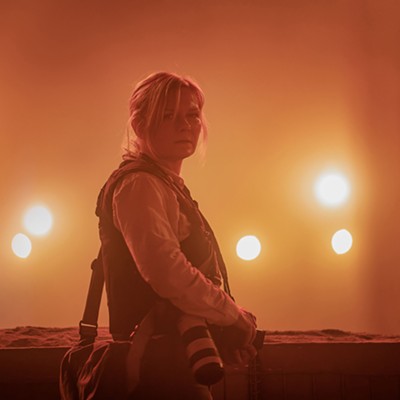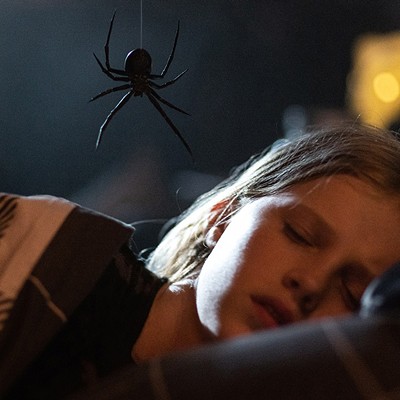After an introductory scene of some Arab men praying in an apartment on the morning of Sept. 11, 2001, the first quiet line of dialogue among them, subtitled in English, is "It's time."
And so, despite the complaints about this film coming out "too soon" after the events of 9/11, after at least one theater in New York pulled the trailer from its screens, let me make two things clear: It is time, and the resulting film has been made with an adherence to the facts -- as we know them -- and with deep respect to the people who were murdered on that awful day.
Of course, the question of "Do I really want to see this film?" comes up, and rightly so. This is 90 minutes of reliving an international tragedy that affected and still strongly affects us all. It would be hard to find an adult or teen today who didn't know exactly where they were and what they were doing when they first heard about the planes hitting the World Trade Center. So do we want to be reminded of it again?
I did, and the emotional whirlwind of an experience that I went through was expansive. I was frightened, I was angry, I was proud, and at three distinct points I was crying. This is one powerful piece of filmmaking about a series of events that we, as Americans, must never forget, must never let diminish in our hearts and minds.
Yes, you really do want to see this film, for many more reasons than those explained above. Plainly speaking, it's a damn good movie, written and directed by a skilled artist who knows exactly how to deal with tough subjects and how to present them with the most impact.
The argument can be made that we will never know what actually happened on that plane. British filmmaker Paul Greengrass has stated that the dialogue used when frantic passengers were making Airfone calls to loved ones was as exact as the people who got those calls could remember. But most of the rest of the dialogue was improvised. In fact, most of the actors portraying the passengers were chosen for their ability to put themselves in this situation. They were then given information from family members and friends -- there was a great deal of cooperation from them in the making of the film, because they wanted it to be done right -- as to how the people they lost might have reacted.
The film isn't at all constricted by taking place in an airplane. It also looks into a number of air traffic control centers around the country where events of the day were playing out, some of them, such as the Trade Tower disasters, on TV screens. For an extra dose of realism, many of the characters in those scenes are played by the actual people who lived through it. So if you're wondering why Ben Sliney, the national operations manager for the FAA (who, incidentally, was on his first day on the job) speaks a little too quickly and stumbles over some of his words, it's because that's a real guy up on the screen, not an actor.
The grip that the film will have on viewers is constant. Cameras jump around in tight spaces, initially showing happy, chatting passengers, a busy, but relaxed flight crew, and four definitely Middle Eastern-looking men who are more than a little nervous. In short order it's revealed that they are vicious killers on a carefully planned mission that appears to be more religious than nationalistic.
Through inventive use of a brooding, thrumming soundtrack that sometimes vanishes for long stretches -- and those absences are deafening -- the film's atmosphere takes on a nerve-racking nature. That's intensified when, as undoubtedly happened in some manner, many of the passengers simply refused to take the situation any longer and lashed out against the terrorists.
Of course, we know how this film is going to end, and Greengrass and his crew have made the final minutes both terrifically exciting and unflinchingly horrifying. We are on that plane, living through some version of what happened. It is totally, utterly exhausting to watch. When the screen goes to black and the credits roll, you will not be able to move. And you will not be at all ashamed if you are crying. Do you want to see this film? Hell, yes.
Why Reopen a Fresh Wound? Before he wrote and directed United 93, British director Paul Greengrass made a series of television films that centered on political violence. He gained art house renown in America with the 2002 documentary-like drama Bloody Sunday, about the murder of innocent Irish protestors by British police in 1972.
Greengrass was in London, just finishing up Bloody Sunday on September 11, 2001, when he got a phone call from a friend who told him to turn on the television because a plane had just hit the World Trade Center.
"And when we turned the television on, the second plane went in," recalls Greengrass. "There were two stages of it. The sort of staggering enormity of that second plane -- when you realized that this was obviously deliberate -- and then all of a sudden, a lull sort of sank in for 20 minutes or half an hour. And then that really frightening thing when the Pentagon got struck. You just thought, 'Where is this gonna end?'"
Greengrass and his crew stopped working on their film for a few days.
"I remember at first thinking, 'This kind of makes Bloody Sunday irrelevant.' But then I realized it didn't, and later, I suppose I felt, well, we have to start to talk about this event," he says of United 93. "What's the point of making the films I've made if I didn't address the most important act?"
United 93; Rated R; Written and directed by Paul Greengrass; Starring Lewis Alsamari, JJ Johnson, Trish Gates















